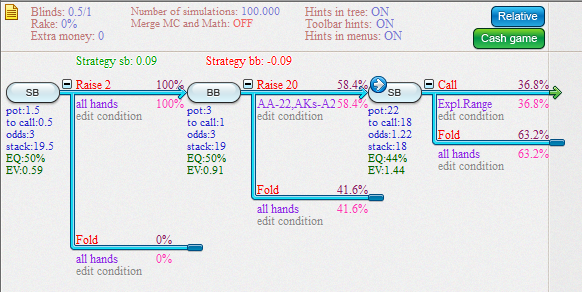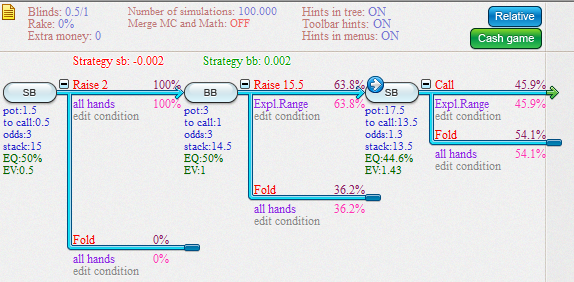sharfeek
12 points
At what date was the video recorded?
As far as i know, Limmy refused to play clicker until they play live.
March 21, 2021 | 8:40 p.m.
It seems blockers can be the case here if we use small raise size. Cause it forces villain to call wider.
Actually solver uses 2 raise sizes here. The smaller one (8bb raise after 2bb bet, with 15% frequency) and bigger one (16bb, 8% freq).
After 8bb raise villain has to call a bunch of not club hands with like 25-50% frequency, such hands as KJo, KTo, QTo, J7o, T8o, T7o, 98o, 97o, and some suited ones ss/hh/dd.
As for bigger size it's not a case, yeah.
March 21, 2021 | 9:13 a.m.
Hi, Luke, great vid, thanks.
T9 hand
I wonder why we choose 4x hands as a preferable bluff raise?
Solver raises them all day.
Villain has tiny amount of bet-calls with 64, 94, T4.
So it seems blocking the calling range is not a case with 4x.
Maybe we want to block a 3 bet range, which has a 44 with a 50% frequency?
Or maybe we want to unblock bet-folding bluff range so we want to have 2x-5x in our hand (42, 43, 53 etc suits well and 92 93 even better cause we block both bet-call and unblock bet-fold range)
Would love to hear your thoughts.
March 20, 2021 | 4:45 p.m.
As was said your range is pretty capped at 56, 85-A5 and sometimes 44-77 if you mix it on the flop but i don't see a problem with that.
After calling the turn his range seems to be 7x, trips, full houses and 86-A6 (probably not all)
When you overbet this river a sufficient part of his turn calling range become bluffcathers or hands not strong enough to value raise you (basically 86 and trips)
So the most important thing on the river we should think about is
Do we have enough bluffs and trips on turn which we are going to fold later so that it is reasonable for him to bluff on the river?
Actually he needs 70% FE with say T6.
Probably we are not going to have so much FE until we are going to fold any trips.
I don't think many regs think you can fold trips here. They definitely can't be 100% sure in this. That is why i think they won't bluff 33% of their range here. But to b honest given the number of his value combos if he bluffs here only 100% on his T6o combos we have to call. So it is really close.
All in all i think fold is good if we play vs good reg.
May 6, 2014 | 5:29 a.m.
Daniel, Rapha, it is very cool that you continue our dialog! Really appreciate it!
Daniel, great post, and yes, the problem is probably that you need to update your current version of CREV.
That's interesting that you offer to break hands into groups.
In what groups i should break them into and what % of realization you think is reasonable for each one?
And another important question is do we need to set equity realization for both players in HU or it is ok to do it for one player (if yes, should it be SB or BB)?
I realise that questions are complicated but there are so little qualified people who can answer that every your message is super valuable for me!
May 6, 2014 | 4:34 a.m.
Daniel Dvoress, ScienceBitch1 and others who are interested
I've just made it in CREV to begin with something:
Please check the file
Some questions:
1. Do 2 opportunities to raise me after limp (3bb or shove) look good or should i add other raising sizes such as 2bb 4 bb etc?
2. Is it ok for BB ro realize 110% of its equity after raising a limp and being called by SB or there should be another number?
3. The same question about realizing 80% of equity when checked back to our limp
April 30, 2014 | 2:29 p.m.
Thank you for posting this, Daniel! Very appreciate it and really have less and less questions left to ask.
the EV of doing something with a hand can shift quite a bit depending how often you take some line with that hand. To give another simple example the expectation of a minraise (your EV GIVEN that you decide to minraise) is much greater with TT+ if you only minraise 1/6th of your TT+ combos
What you mean is that if in first case i have say the EV1,1 with minraising TT (and have strong mr range) against max exploit and in second case use 2 ranges (1/6 mr + 5/6 limp with TT) and have EV1,2 after max exploiting us even given the fact i made the mr range weak? (And the reason for it that while i made mr range weaker my limping range became much stronger what make me feel good about adding some weak hands in it)
So are you saying (just to make it clear) that splitting a hand like TT (and probably many others) into 2 ranges if very often has overall more +EV even if villain play max exploit against both our lines?
In other words - our plan in building ranges is probably something like:
1. We design one line (until it includes only hands having +EV)
2. We make an assumpsion that many hands which are in this range or are open folded can be played with more EV that in current situation so that the EV of our whole strategy is higher than in point 1.
3. We are starting to work with weights of hands (time after time trying to find the most profitable option) designing the whole strategy so that it has good board coverage and villain can't have the EV more than in point 1 (when we had 1 range)
Am i right?
April 30, 2014 | 4:44 a.m.
April 29, 2014 | 5:48 a.m.
Very useful. It seems to me that you're trying to explain explotive strategy and approach to the game. I mean we know some wrong villain frequences an make the most profitable adjustment we can with each particular hand.
What i want to talk about is designing well balanced ranges against qualified regs.
Do i understand you correctly that in this case we are going to find out Nash solution that can also contain mixed strategy for particular hands like in the example with AA? (Using weight option in CREV) Am i right?
Can we say that in this case we have the maximum EV for all hands we can practicaly have against villain's max exploit strategy trying not to be exptloited?
What i want to say is that i understood the concept of playing max exploitive but i don't have a clear vision of how to practically balance our preflop ranges.
Btw sorry for many mistakes, English isn't my native language.
April 29, 2014 | 4:49 a.m.
Thanks for detailed answer. I probably understand what you are talking about.
Does the statement that all hands in our Nash range should have +EV applicable to constructing a limping range? I mean if we have 3 ranges from SB (mr, limp and open fold) do all 3 will contain at least 0EV hands or it is possible to have -EV hands in any range?
We have some K6, Q7, 98 and other hands that have miserable +EV playing it minraising. If i understand you correctly we can play them more profitable by limping. My question is if we balance limping range by adding some value so that villain couldn't raise too effectively is our main goal to have +EV strategy with all +EV hands in our ranges despite the fact that we earn more playing for example AA more +EV by minraising it rather than limping? In other words do we consiously strengthen our limping range knowing that value hands will have less +EV but K6 and other marginal hands will compensate it making our whole strategy more +EV than in case we have only MR/F ranges?
It's also interesting what other concepts and rules we are going to use while constructing our limping range?
April 26, 2014 | 10:29 p.m.
Hi, Daniel! First of all let me thank you for the video!
Here are some thoughts and questions.
While watching a video i opened CREV and created the situation where SB minraises 100% of hands.
As BB response i used 10bb Nash Eq. which says to push about 58% of hands and fold the rest.
And i was surprised to see that despite the fact about 63% of hands SB minraises have -EV the whole strategy has +9bb/100.
You can see the screen below:

I agree with your calculations in 10bb POF game (-0,045 for SB) but in case we play 20bb deep the situation is opposite since SB posts big blind hence the whole strategy of BB becomes minus EV (-0,045*2=-0,09 as you can see on the screen). It means that minraising 100% hands in 20bb is still profitable which contradicts your version.
Following this logic i found the maximum stack depth in which SB can auto profit in POF game:

As you can see if effective stack size is below 15.5bb BB can make an auto profit in POF game and forces SB not to minraise 100% hands.
Actually i'm now sure if i'm right so it would be cool to get your feedback!
Bad thing RIO site engine doesn't allow to size up images by clicking on them. Prb a nice idea to write to support to fix it. Great topic, gl, demondoink :)
May 13, 2021 | 9:18 p.m.